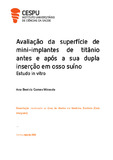| dc.contributor.advisor | SANTOS, PRIMAVERA DA CONCEIÇÃO MARTINS DE SOUSA | |
| dc.contributor.author | Miranda, Ana Beatriz Gomes | |
| dc.date.accessioned | 2023-11-23T16:06:13Z | |
| dc.date.available | 2023-11-23T16:06:13Z | |
| dc.date.issued | 2023 | |
| dc.identifier.uri | http://hdl.handle.net/20.500.11816/4446 | |
| dc.description.abstract | Introdução: Os MIs (mini-implantes) são dispositivos de ancoragem eficazes e amplamente aceites pelos ortodontistas. Diversas situações requerem a recolocação dos MIs, fator que, aliado ao aspeto económico, levanta a questão da reutilização dos mesmos. As alterações provocadas pela inserção dos MIs podem ser decisivas no seu sucesso.
Objetivo: Aferir as alterações na superfície dos MIs, após a sua dupla inserção em osso suíno.
Material e Métodos: Pesquisa bibliográfica realizada na PubMed, selecionando-se 21 artigos. Acrescentou-se 4 artigos por pesquisa manual. 30 MIs foram divididos em 3 grupos: Grupo 1 (G1): grupo controlo: MIs novos; Grupo 2 (G2): grupo experimental: MIs inseridos no osso; Grupo 3(G3): grupo experimental: MIs inseridos duas vezes no osso. Os 3 grupos foram observados ao microscópio eletrónico de varrimento. Uma análise química pela técnica de espectroscopia de energia dispersiva foi realizada numa área de interesse.
Resultados: Os MIs novos apresentam deformação plástica e contaminação da sua superfície. A alteração mais significativa encontrada foi o encurtamento e arredondamento da ponta ativa (G2 e G3), sendo mais acentuados no G3. Carbono foi encontrado nos 3 grupos.
Discussão: As alterações encontradas nos MIs novos são presumivelmente derivadas do fabrico. O desgaste da ponta ativa no G2 e G3 torna-se um dado relevante porque sendo o local que mais sofre impacto durante a inserção, apresenta maior risco de fratura.
Conclusão: A alteração mais significativa observada foi o desgaste da ponta ativa (G2 e G3). | pt_PT |
| dc.description.abstract | Introduction: MIs (mini-implants) are effective anchorage devices widely accepted by orthodontists. Several situations require MIs relocation, a factor that, combined with the economic dimension, raises the question of their reuse. The changes caused by the MIs insertion can be decisive for their success.
Objective: Evaluate the changes on the surface of MIs after their double insertion in suine bone.
Material and Methods: Bibliographic research on the PubMed platform, selecting 21 articles. Four articles were added by manual research. 30 MIs were divided into 3 groups: Group 1 (G1): control group: new MIs; Group 2 (G2): experimental group: MIs inserted in bone; Group 3(G3): experimental group: MIs inserted twice in the bone. The 3 groups were observed under the scanning electron microscope. A chemical analysis by energy dispersive spectroscopy technique was performed on an area of interest.
Results: The new MIs show plastic deformation and contamination of their surface. The most significant alteration found was the shortening and rounding of the active tip (G2 and G3), being more pronounced in G3. Carbon was found in the 3 groups.
Discussion: The changes found in new MIs are presumably derived from manufacturing. The wear of the active tip in G2 and G3 becomes a relevant data, because being the site that suffers most impact during insertion, presents the higher risk of fracture.
Conclusion: The most significant change observed was the wear of the active tip (G2 and G3). | pt_PT |
| dc.language.iso | por | pt_PT |
| dc.rights | info:eu-repo/semantics/openAccess | pt_PT |
| dc.subject | Sterilized miniscrews | pt_PT |
| dc.subject | Surface analysis | pt_PT |
| dc.subject | Miniscrews | pt_PT |
| dc.subject | Orthodontic mini-implants | pt_PT |
| dc.subject | Retrieved miniscrews | pt_PT |
| dc.subject.ddc | Scanning electron microscopy | |
| dc.title | Avaliação da superfície de mini-implantes de titânio antes e após a sua dupla inserção em osso suíno Estudo in vitro | pt_PT |
| dc.type | info:eu-repo/semantics/masterThesis | pt_PT |
| dc.identifier.tid | 203356772 | pt_PT |
| thesis.degree.name | Mestrado em Medicina Dentária | pt_PT |

